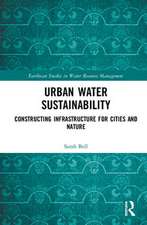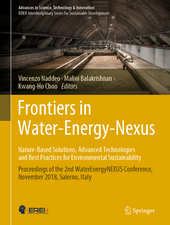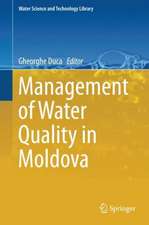Optimization of Biological Sulphate Reduction to Treat Inorganic Wastewaters: Process Control and Potential Use of Methane as Electron Donor: IHE Delft PhD Thesis Series
Autor Joana Cassidyen Limba Engleză Paperback – 19 sep 2016
Feast/famine regimes, applied to design the control strategy, were shown to induce the accumulation of storage compounds in the sulphate reducing biomass. This study showed that delays in the response time and a high control gain can be considered as the most critical factors affecting a sulphide control strategy in bioreactors. The delays are caused by the induction of different metabolic pathways in the anaerobic sludge, including the accumulation of storage products. On this basis, a mathematical model was developed and validated. This can be used to develop optimal control strategies.
In order to understand the microbial pathways in the anaerobic oxidation of methane coupled to sulphate reduction (AOM-SR), diverse potential electron donors and acceptors were added to in vitro incubations of an AOM-SR enrichment at high pressure. Acetate was formed in the control group, probably resulting from the reduction of CO2. These results support the hypothesis that acetate may serve as an intermediate in the AOM-SR process.
Din seria IHE Delft PhD Thesis Series
-
 Preț: 355.20 lei
Preț: 355.20 lei - 23%
 Preț: 473.10 lei
Preț: 473.10 lei - 17%
 Preț: 257.23 lei
Preț: 257.23 lei - 28%
 Preț: 492.31 lei
Preț: 492.31 lei - 23%
 Preț: 472.25 lei
Preț: 472.25 lei - 13%
 Preț: 322.51 lei
Preț: 322.51 lei - 29%
 Preț: 524.35 lei
Preț: 524.35 lei - 31%
 Preț: 295.46 lei
Preț: 295.46 lei - 22%
 Preț: 399.88 lei
Preț: 399.88 lei - 30%
 Preț: 1015.76 lei
Preț: 1015.76 lei - 17%
 Preț: 268.83 lei
Preț: 268.83 lei - 18%
 Preț: 254.47 lei
Preț: 254.47 lei - 25%
 Preț: 339.78 lei
Preț: 339.78 lei - 13%
 Preț: 322.01 lei
Preț: 322.01 lei - 26%
 Preț: 455.79 lei
Preț: 455.79 lei - 22%
 Preț: 399.48 lei
Preț: 399.48 lei - 27%
 Preț: 427.41 lei
Preț: 427.41 lei - 22%
 Preț: 371.52 lei
Preț: 371.52 lei - 26%
 Preț: 373.21 lei
Preț: 373.21 lei - 22%
 Preț: 328.64 lei
Preț: 328.64 lei - 13%
 Preț: 348.86 lei
Preț: 348.86 lei - 22%
 Preț: 369.82 lei
Preț: 369.82 lei - 18%
 Preț: 174.31 lei
Preț: 174.31 lei - 22%
 Preț: 414.78 lei
Preț: 414.78 lei - 23%
 Preț: 454.94 lei
Preț: 454.94 lei - 23%
 Preț: 315.45 lei
Preț: 315.45 lei - 17%
 Preț: 257.23 lei
Preț: 257.23 lei - 13%
 Preț: 296.68 lei
Preț: 296.68 lei - 22%
 Preț: 353.39 lei
Preț: 353.39 lei - 23%
 Preț: 326.95 lei
Preț: 326.95 lei - 13%
 Preț: 348.40 lei
Preț: 348.40 lei - 23%
 Preț: 367.30 lei
Preț: 367.30 lei - 22%
 Preț: 322.47 lei
Preț: 322.47 lei - 27%
 Preț: 425.74 lei
Preț: 425.74 lei - 17%
 Preț: 212.40 lei
Preț: 212.40 lei - 23%
 Preț: 473.94 lei
Preț: 473.94 lei - 13%
 Preț: 322.98 lei
Preț: 322.98 lei - 23%
 Preț: 367.73 lei
Preț: 367.73 lei - 22%
 Preț: 328.22 lei
Preț: 328.22 lei - 23%
 Preț: 350.43 lei
Preț: 350.43 lei - 25%
 Preț: 472.25 lei
Preț: 472.25 lei - 28%
 Preț: 498.58 lei
Preț: 498.58 lei - 23%
 Preț: 349.16 lei
Preț: 349.16 lei - 18%
 Preț: 162.13 lei
Preț: 162.13 lei - 13%
 Preț: 350.29 lei
Preț: 350.29 lei - 28%
 Preț: 550.16 lei
Preț: 550.16 lei - 25%
 Preț: 552.62 lei
Preț: 552.62 lei - 23%
 Preț: 384.59 lei
Preț: 384.59 lei - 18%
 Preț: 175.64 lei
Preț: 175.64 lei
Preț: 256.76 lei
Preț vechi: 460.47 lei
-44% Nou
Puncte Express: 385
Preț estimativ în valută:
49.13€ • 51.30$ • 40.66£
49.13€ • 51.30$ • 40.66£
Carte tipărită la comandă
Livrare economică 04-18 aprilie
Preluare comenzi: 021 569.72.76
Specificații
ISBN-13: 9781138029507
ISBN-10: 1138029505
Pagini: 178
Dimensiuni: 170 x 240 x 10 mm
Greutate: 0.29 kg
Ediția:1
Editura: CRC Press
Colecția CRC Press
Seria IHE Delft PhD Thesis Series
ISBN-10: 1138029505
Pagini: 178
Dimensiuni: 170 x 240 x 10 mm
Greutate: 0.29 kg
Ediția:1
Editura: CRC Press
Colecția CRC Press
Seria IHE Delft PhD Thesis Series
Public țintă
PostgraduateCuprins
Chapter 1: Introduction. Chapter 2: Automated Biological Sulphate Reduction: A Review on Mathematical Models, Monitoring and Bioprocess Control. Chapter 3: Sulphide Response Analysis for Sulphide Control Using a pS Electrode in Sulphate Reducing Bioreactors. Chapter 4: Bioprocess Control of Sulphate Reduction in an Inverse Fluidized Bed Reactor: Role of Microbial Accumulation and Dynamic Mathematical Modelling. Chapter 5: Effect of Alternative Co-Substrates on the Rate of Anaerobic Oxidation of Methane and Sulphate Reduction. Chapter 6: General Discussion and Recommendations.
Descriere
This work showed two possible approaches to optimize biological sulphate reduction: a) the development of a control strategy to optimize the input of the electron donor taking into account the accumulation of microbial storage products. A validated mathematical model is presented to assist in the sulphide control strategy; and b) the feasibility of using methane as a carbon source for biological sulphate reduction and possibly other co-substrates to expedite the process.














